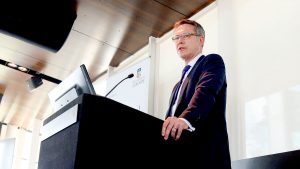Simon Hackett, the executive chairman of Australian battery storage maker Redflow, says it is now clear that 2016 will be an inflexion point for the battery storage market in Australia, given huge interest from consumers and the rush of new products to the market.
Redflow is preparing to release its 10kWh zinc bromine “flow” battery, known as the ZCell, into the market in August, where it will be competing with a host of new lithium-ion batteries, some of which – such as Enphase – are already reporting significantly higher than anticipated sales.
 Hackett is getting the same signals from customers. “It is going to be quicker than anyone thought,” he told RenewEconomy at the Energy Storage conference in Sydney. “Every sense I get at the moment is that this is finally the inflexion year, and it is going mad.”
Hackett is getting the same signals from customers. “It is going to be quicker than anyone thought,” he told RenewEconomy at the Energy Storage conference in Sydney. “Every sense I get at the moment is that this is finally the inflexion year, and it is going mad.”
Hackett says the market has Tesla – and its Powerwall product – to thank for bringing the market forward several years.
“It was always going to happen at some point, but one of the sexiest brands in the world has turned it (battery storage) into a dinner table conversation.
“When you do that … humans are herd animals … You will buy something and because you mention it, your friend nods their head and says I will think about it too. That’s how you get exponential take-up. We’re there. It’s now a dinner table conversation.”
To be sure, Hackett says that despite the huge interest, it is still an “early adopter” market. The ZCell retails at around $18,000 a system, but Hackett says that the early adopter is strong enough that it will flow through to the mass market as costs come down, which they will.
The key, he says, is ensuring that software that goes with the battery storage is smart enough to make it effective for the consumer – otherwise it will just be an early adopter market.
Hackett has installed battery storage in his office building in Adelaide, Base64, from where he is also charging his Tesla electric vehicles. More recently, he says, has added two ZCells to his home – replacing a lead acid battery storage array he installed in 2010 – which will support his 10kW of rooftop solar.
“I put 20kWh of lead acid in 2010, with 10kw of solar, when there was no business case. It was a $100,000 investment and it was the epitome of early adopter madness,” Hackett said.
“So I ripped the lead acid out and put the Redflow in as a solar self consumption exercise, so the batteries only charge when sun is shining and they defer drawing from the grid when the sun goes down. On a sunny day, we use about 5 per cent grid. On a rainy we use more, which is why disconnecting from the grid is not such a smart idea.”
But off grid does make sense to some. Redflow has also delivered its first batteries to a commercial customer, a landowner in Wilunga, south of Adelaide, who is looking to build a new home and was quoted $150,000 to string a line some 600m from the local poles and wires.
“So, for $40,000, he’s put in a kick-arse off grid power system with two of our batteries and a lot of solar panels, and he says thank you for giving me a business case. There is a whole city fringe thing where that works.”
Hackett says that the Redflow battery – though expensive for a single unit – competes with others on cost per kilowatt-hour, and is just at the start of the “cost down curve”, which will come from optimising the manufacturing process.
“The battle for Redflow hasn’t been to make it cheap, but to make it reliable and manufacturable. That nut we have now cracked, that is why we can do the cost downs,” Hackett says.
“Doing it the other way isn’t useful because we might end up with a cost effective battery that no one wants to buy. That was the pitfall of every electric vehicle manufacturer before Tesla. They wanted to make a cheap and cheerful EV from a company you never heard of, that is why they never sold them.
“Tesla did the high cost, aspirational stuff. You start with early adopters. There is no shortage of early adopters at the current pricing. Pricing is not the barrier, it is simply execution.”
Hackett also addressed the issue of safety of the zinc bromine flow battery. He says critics of new technology often overlook the pitfalls of the current one.
Zinc bromine, he says, is no more “nasty” than lead acid or lithium. And zinc bromine is a fire retardant. “As a chemical it is no worse than lead acid, you have got a built in fluid containment system and unless you physically break that sealed system, I don’t have a problem.”
He pointed to the long practice of filling cars at petrol stations. “People will complain about the downsides they perceive in EVs, while ignoring the volatile carcinogenic, inflammable fuels that you load into car each week.
“If you came into 2016, and the petrol filling mechanisms didn’t exist, they would be banned by OHS regulations.










